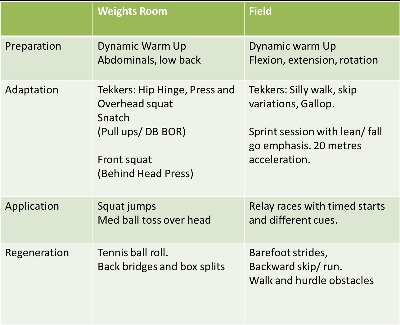Main Menu
Latest Blog Entry
User login
How to Eat a Big Elephant
 “It’s a big elephant: you can’t eat it all at once.”
“It’s a big elephant: you can’t eat it all at once.”
This sums up trying to get a sports team fit in season: there is so much to do, so little time, so many variables. A seasonal plan will help you.
“How can I get my team fit?” is a question I tried to answer yesterday on the CPD day with the Level 1 and Level 2 S&C coaches.
Start with a Needs Analysis.
- What are the requirements of the sport?
- How much time do I have?
- What are the position needs?
- What facilties do I have?
- What level are my players at now?
- What does the technical/ tactical training stimulate already?
These were just some of the questions that we looked at. Then we rapidly realised that this was quite a daunting task, so we broke it down to “Need to do versus Nice to do” (Gambetta).
The goals then become more manageable, we just have to plan that in and around the training.
Fitting it all in.
I then showed some example plans of how to fit in the different components of fitness that are needed. This includes using warm ups, small sided games, pre-match training, home training, and gym training.
Time is precious and should not be wasted. If a fitness component is being developed in games and team training, then there is no need to work on it seperately. This will overload the players and is a waste of time.
Developing aspects of fitness such as speed, power and strength, as well as maximal anaerobic qualities is best done in specific sessions. Balance, control, flexibility, agility and aerobic qualities can be developed in team training sessions with judicious use of warm ups and session planning.
Maintaining what?
The idea of a 6 week pre-season training and then in season “maintenance” was brought up. I questioned how players could maintain a quality they haven’t developed. We looked at detraining time frames and how the in-season training must develop fitness because the pre-seasons are so short.
I favour 14-21 day microcycles within a 2 month training block. Each micro cycle has a major emphasis with a minor emphasis. This then either repeats and extends over the course of the year, or is followed by a complementary microcycle that allows different fitness aspects to develop.
This depends on competition schedules and what the team is trying to peak towards. For school athletes this has to be adapted according to term times and factor in exam schedules too.
Longer microcycles mean that components that are not being developed go backwards in a hurry. It also allows the components to:
- Stimulate
- Adapt
- Stabilise
- Actualise (Dan Pfaff)
(Sports that have one major component may consider using Block Periodisation.)
The sesson plan.

This was the first time these coaches had actually been coached by me, so I wanted to show how I incorporate the principles in practice. Each session was 30 minutes, purely for demonstration purposes, but there was little waste.
Monitoring and evaluating.
The coaches were asking lots of questions as we went along, and I was happy to answer them: the downside being that we were behind schedule. We touched on the difficulty of monitoring in season. It is important to collect and use the right data without becoming “random number gatherers” (Kelvin Giles)
This is going to be our focus as part of our community of practice before our next session in 2013. We will share the ides discussed as a group.
The coaches gave some really useful feedback at the end of the day; including ideas for future workshops. They were challenging me and my knowledge and practice which is helpful I was encouraging them to connect the dots not just collect them.
You can’t eat an elephant in one sitting, just take it one bite at a time.
This was the second in our series of CPD events that are exclusive to coaches who have completed the Level 1 or Level 2 Strength and Conditioning Coaching Course with us.
Client Testimonials
 Blundells School
Blundells School
James has a huge breath and depth of knowledge on fitness issues. He is able to implement this knowledge into a practical course both making the task of fitness and conditioning both different and interesting from other fitness training that most are familiar with. He understands the safety issues when dealing with young adults strength and conditioning programmes. Programmes he sets are tailored to the individual needs of the group. There was a huge amount of progress made with some of these individuals in terms of their understanding of fitness and their own fitness levels.
More


Comments
[…] I am looking forward to seeing some of these coaches again when they attend our quarterly CPD workshops . […]
[…] How to plan your teams’ training […]
[…] Planning your in season training […]
[…] CPD workshops included “In season training” and “agility […]
[…] How to plan your team’s fitness training […]
[…] Planning your training programme in season […]